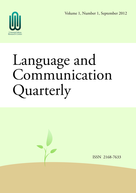


Volume 10 Issues 1-4 (2021-12-31)
Volume 9 Issues 1-4 (2020-12-31)
Volume 8 Issues 1&2 (2019-06-30)
Volume 7 Issues 3&4 (2018-12-31)
Volume 7 Issues 1&2 (2018-06-30)
Volume 6 Issues 3&4 (2017-12-31)
Volume 6 Issues 1&2 (2017-06-30)
Volume 5 Issues 3&4 (2016-12-31)
Volume 5 Issues 1&2 (2016-06-30)
Volume 4 Issues 3&4 (2015-12-31)
Developing ESL students’ effective intercultural communicative competence (ICC) has become extremely important at North American schools. However, research has shown that their insufficient English language proficiency, coupled with their unfamiliarity with the North American culture has prevented them from communicating effectively with their North American teachers and peers. This review paper examines the development of ESL students’ ICC at North American school context. Specifically, it first defines and explains the concept of ICC for ESL students; it then discusses the importance of developing ESL students’ ICC; it further describes the major challenges in developing ESL students’ ICC; and it finally explores the causes of ESL students’ intercultural miscommunication. Important implications for ESL teachers are discussed.
Using item response theory (IRT) as a statistical framework, a gender-based differential item functioning (DIF) analysis was conducted to determine if Chinese college male and female students performed differently on each question of the English Pragmatic Competence Test for Chinese College Students. SIBTEST analysis indicated that four items displayed DIF and potentially led to gender bias. Results of this study have important implications for non-native language teachers, students, test developers, and administrators.
This study investigated tertiary English-as-a-foreign-language (EFL) teachers’ assessment practices in China. The following three questions guided the study: a) What kind of assessment techniques do Chinese tertiary EFL teachers use in their classrooms? b) To what extent do Chinese tertiary EFL teachers monitor and scaffold their students to support learning? c) Are there significant differences in the perceived monitoring and scaffolding practices among Chinese tertiary EFL teachers across demographic variables? The current study yielded some significant findings. For example, Chinese EFL teachers employ many different techniques to assess students in the classroom and they monitor and scaffold students’ learning to a great extent. However, significant differences exist among teachers across their academic titles, colleges they graduated from and training in language assessment. Important implications are discussed.
The 5th Untested Ideas International Research Conference Collaborating for Change in Research and Practice